Fact Sheet FS1098
The bed bug, (Cimex lectularius L), is a bloodsucking insect that is closely associated with humans. It is occasionally found on poultry farms and on indoor pets (dogs, cats, rodents). Since the late 1990's, there has been a steady increase in the number of bed bug infestations in the U.S., Canada, Europe, and Australia (Harlan 2006). They can be found in hotels, dormitories, homes, and shelters. The recent increase in bed bug cases may be related to increased travel and the lack of effective control tools. In most parts of the U.S., only one species of bed bug is encountered. A similar species, bat bug, is occasionally found in homes that have active or recently eliminated bat infestations. Bat bugs and bed bugs look very similar, but have different behaviors and are found in different locations. Therefore, it is important to correctly identify the species before doing any control work.
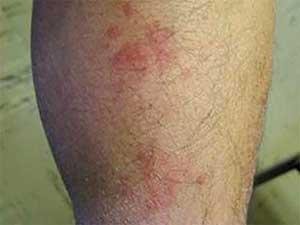
Figure 1.
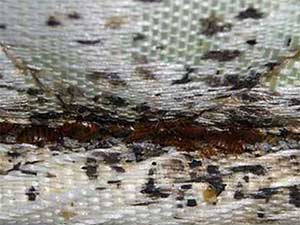
Figure 2.
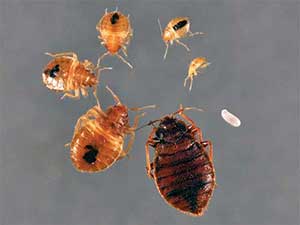
Figure 3.
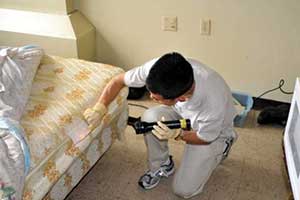
Figure 4.
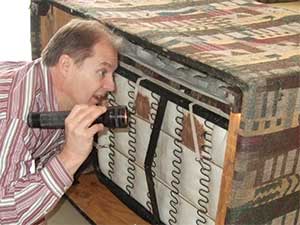
Figure 5.
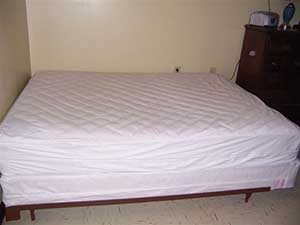
Figure 6.
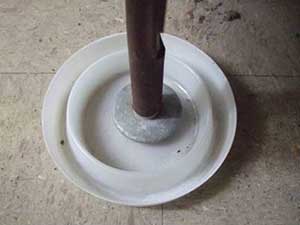
Figure 7.
Effect on Human Health
Most people develop red welts and itchiness after being bitten by bed bugs. The red welts and itchiness will last for a few days (Figure 1). Some people do not develop any symptoms. Unlike mosquitoes, bed bugs do not transmit diseases. However, bed bugs must feed many times on humans to finish their life cycle and depend solely on blood for food.
What They Look Like
Bed bugs are flat, oval-shaped wingless insects (Figure 3). Their eggs are white and about the size of a pinhead. The immature stages (nymphs) are yellow to light tan in color and have a distinct irregularly shaped black spot near the end of the body. Adult bed bugs are mahogany red in color and are ¼ inch long.
Biology and Behavior
Bed bugs undergo five immature growth periods before turning into an adult. The development time from egg to adult takes as little as one month but can last up to 4 months. Colder temperatures and starvation will delay their development. Bed bugs need to feed at least once during each period before developing into the next stage. They usually can survive without feeding for a few months. In some instances, they may live for greater than a year without feeding. Female bed bugs lay a few eggs each day and up to 500 eggs during their life time.
Bed bugs usually come out at night to feed. They are attracted to the carbon dioxide, heat, and smell released by a human host. If hungry, bed bugs will feed during the day. Bed bugs spend up to 10 minutes on a host to complete a meal. After feeding, bed bugs immediately return to their hiding places. They defecate after feeding and leave characteristic black or brown spots, often on the bed sheets and mattresses, which are typical signs of bed bug infestations (Figure 2).
Bed bugs are usually found in or around beds or sofas where people spend long periods of time (Figure 2). They hide in the seams of mattresses and box springs, inside nail holes or other holes and crevices in the furniture, at the edges of blanket or quilts and corners, at the corners of head and foot boards, behind baseboards, in holes and crevices in walls, on curtains, inside electric outlets, and inside any other clutter surrounding the bed or sofa. When the populations are high, bed bugs can be found throughout a room and in neighboring rooms such as bathroom and kitchen. Bed bugs spread to adjoining apartments (rooms) through hallways and other structural pathways existing in the common wall between two apartments (rooms). Long-distance spread of bed bugs is possible through human activities such as travelling or moving infested furniture.
Prevention
Bed bugs are difficult to find and control because of their small size, cryptic behavior, and lack of effective control tools. So it is important to keep alert and take preventative measures when travelling, moving, and bringing in used furniture from outside:
Control
Because of the complexity of inspecting and treating bed bugs, and the human exposure risks associated with bed bug control treatments, it is a good idea to hire experienced professional pest control firms to handle the bed bug infestations. There are many non-chemical and chemical methods to control bed bugs. Unfortunately, none of them alone will guarantee elimination of bed bugs. Multiple approaches, resident collaboration, and a long period of time (a few weeks to months) are required to successfully eliminate all bed bugs.
The following is a step-by-step approach for residents or property managers who want to control bed bugs themselves:
- Conduct a systematic inspection of the entire residence using a flashlight and collecting tools (brush, forceps, and glass jar for holding the bed bugs) (Figure 4 and 5). Collect or kill all bed bug eggs, nymphs, and adults found during inspection. Emphasis should be placed on beds, sofas, chairs, and wheelchairs where the residents spend most of their time. Turn over and disassemble the furniture if possible to find all bed bug hiding places.
- Use a hot steam machine to kill large numbers of bed bugs in heavily infested areas. Bed bugs are very susceptible to high temperatures (> 120 °F) (Wang et al. 2016a).
- Immediately put infested materials (clothes, bed linens, shoes, books, toys, small furniture, electronics, curtains, etc.) in heavy duty plastic bags and seal them to avoid recontamination. Wash and hot dry the items if possible. Non-washable items can be placed in a hot dryer or a freezer for a few weeks to kill all bed bugs present. Safely discard heavily infested items that can not be washed or effectively de-infested by hot steam.
- Remove or reduce clutter from the infested room.
- Install encasements around mattresses or box springs (Figure 6). This will permanently seal off many bed bugs that are missed during the inspection, eliminate bed bug hiding places, and make future inspections much easier.
- Apply a layer of silica gel dust to the corners, crevices, and holes on the disassembled bed frame (Singh et al. 2016). The same can be done to sofas, behind baseboards, and inside electric or telephone outlets. Liquid insecticides labeled for bed bugs can also be applied to bed frames, baseboards, and other areas where bed bugs are found for long-term protection. It is more effective to kill bed bugs by applying the chemicals directly onto bed bugs than relying on the dry residues. Due to prevalence of insecticide resistance in field bed bug populations, insecticides containing two different classes are more effective than pyrethroid-based sprays (Wang et al. 2016b). It is important to keep in mind that all pesticides must be applied following the label directions.
- Install pitfall style bed bug monitors under all bed and sofa legs. A commercial bed bug interceptor (CLIMBUPTM, Susan McKnight, Inc.) is very effective for detecting bed bugs that travel between the furniture and the floor (Figure 7) (Wang and Cooper 2012). Bed bugs moving to or from the bed and sofa will be trapped in the interceptor. The interceptor can also be placed around perimeters of the room or around upholstered furniture to monitor the presence of bed bugs and to verify whether bed bugs are eliminated in a room. The bed and sofa must be pulled away from walls so that bed bugs can only reach the furniture via the furniture legs.
- Seal holes and crevices in the wall.
- Repeat steps 1 and 2, and check the interceptors every 7–10 days until no bed bugs are found for a month. During each inspection, remove the bed bugs caught in the interceptors. A hand-held magnifier will be needed to identify the small bed bug nymphs. Clean the interceptors with cloth. Add a thin layer of talcum powder if necessary after each examination.
- In multi-unit buildings, all apartments (rooms) and the common areas need to be inspected and treated (if necessary) following the above procedures.
References
Mention or display of a trademark, proprietary product, or firm in text or figures does not constitute an endorsement by Rutgers Cooperative Extension and does not imply approval to the exclusion of other suitable products or firms.
Photo credits: Changlu Wang (photos 1 and 3–7) and J. Obermeyer (photo 2).
February 2019
Copyright © 2024 Rutgers, The State University of New Jersey. All rights reserved.
For more information: njaes.rutgers.edu.
Cooperating Agencies: Rutgers, The State University of New Jersey, U.S. Department of Agriculture, and Boards of County Commissioners. Rutgers Cooperative Extension, a unit of the Rutgers New Jersey Agricultural Experiment Station, is an equal opportunity program provider and employer.

